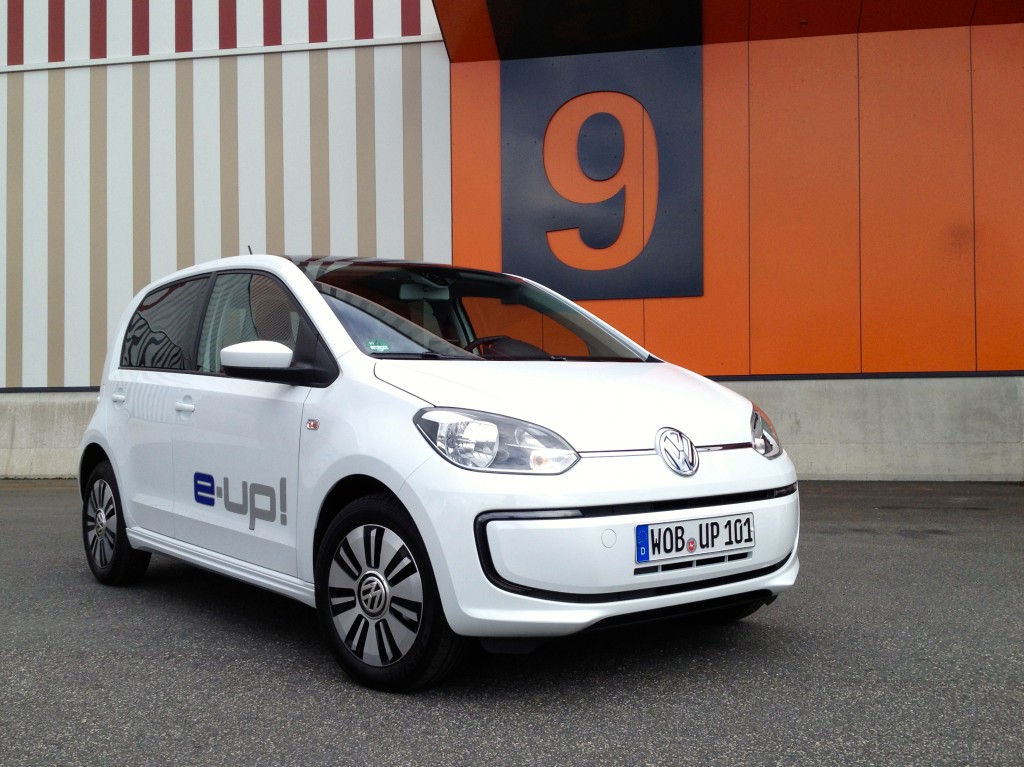First Drive: 2014 Volkswagen e-Up!
Story and photos by John LeBlanc
FRANKFURT — Initially conceived as a rear-engine, rear-drive city car, the first production Volkswagen Up! went on sale in Europe as a front-drive, two-door, four-passenger hatch two years ago. But Volkswagen always had bigger plans for its smallest car.
At the Frankfurt auto show in 2011, the German automaker rolled out six Up! concepts. Some were pure fancy, like the Myers Manx-inspired Buggy Up! Some, like the turbocharged Up! GT, were almost sexy. And now, two years later, the four-door, pure-electric e-Up! is going on-sale in Europe as Volkswagen’s first-ever production electric vehicle (EV).
The new e-Up! is just the beginning of parent Volkswagen Group’s global EV onslaught. The electrified Up! was joined on stage at this year’s Frankfurt show by the larger e-Golf and Audi e-Tron compacts, set to hit European showrooms next spring. And that’s just the start. Although Nissan is the current world EV sales champ with its popular Leaf, by 2014, the Volkswagen Group plans to have 14 new hybrid and electric models on sale, with the potential for upwards of 40 vehicles with alternative powertrains.

The secret sauce to Volkswagen’s seemingly quick jump into the EV market lies with its new modular transverse matrix (MQB) platform, a Lego-like unibody structure that can produce wildly diverse vehicles like the very small Up! all the way to the very large CrossBlue crossover concept.
As well, every MQB vehicle has been designed from the outset to be powered not only by conventional internal combustion (ICE) gas and diesel engines, but also natural gas, hybrid or — as in the case of the e-Up! here — pure-electric powertrains. The strategy also allows Volkswagen to price the e-Up! competitively. In Germany, it sells for just more than $37,000. That’s twice the most-expensive non-electric Up!, but about $14,000 less than BMW’s i3 electric city car.
Currently, the most miserly fossil fuel Up! models score a Toyota Prius-beating 3.7 L/100 km in Europe. But, obviously, the electric version sips no fuel at all. With an 81-horsepower (seven more than the most powerful gas Up!) and 155 pound-feet of torque (about double other Up!s) electric motor (powered by an 18.7-kilowatt per hour battery pack hidden under its rear seat) sitting on top of the city car’s front transaxle, Volkswagen says the e-Up! can go up to 160 kilometres fully charged. On a “regular” power outlet, the e-Up! takes nine hours for a full recharge, but an optional fast charger can boost its battery pack to 80% capacity in just 30 minutes.

Thankfully, the conversion to electric power hasn’t affected the Up!’s already excellent cabin. Two sizes down from the compact Golf, the Up! is even smaller than the subcompact European Polo, but it doesn’t feel like a toy car when you sit inside. To create as much passenger room as possible, the Up’s wheels have been pushed to the far reaches of its extra-long wheelbase — longer than a Fiat 500, Smart ForTwo or Scion iQ. Its cabin is airy, and the driving position feels little different from the bigger Golf, with everything the driver touches (steering wheel, seats, gear shift knob) of similar high quality fit and finish.
My drive time in the new e-Up! was limited to a few kilometres on some city streets around the Frankfurt auto show grounds. Range anxiety aside, though, the electric version is the better Up! to drive.
Instead of a five-speed manual or autobox, the e-Up gets a single-gear automatic with two modes. D is for normal driving, with D1 through to D3 ratcheting up the regenerative braking systems energy recovery (to the point where you almost don’t have to use the brakes in D3 to stop at low speeds). There are also three — Normal, Eco and Eco Plus — switches between the front seats that affect battery usage. Eco limits battery power to 50 kW and Eco Plus limits power a further 10 kW, with the resulting lack of forward oomph.

Volkswagen says adding the “e” to the Up! only adds 210 kilograms of weight, but the tidy city car still only weighs in at 1,139 kg. Because of this, and the inherent instant torque from its electric motor, the e-Up! is the quickest model to go from rest to 100 km/h.
That said, the e-Up! takes 12.4 seconds to go from rest to 100 km/h, so you won’t be scaring any Golf GTI drivers at stoplights. If you have the patience, top speed is 133 km/h, but initial the run-up to typical urban speeds is both quick and quiet. Just like the ICE Up!, the electric version muffles exterior wind and road noise effectively, and the near-silent drivetrain only makes the Up! quieter.
If you can live with its limited range between charges, as an everyday urban runabout, there’s much to like about the new e-Up! It can seat four comfortably in an upscale cabin, offer the safety and reliability of a bigger car, and deliver a quiet, refined driving experience — and wait for it — sip no gas!
The chances of the e-Up! coming to Canada are slim at best, but Volkswagen has already told the media it plans on selling EVs in the U.S. by 2015. More than likely, we’ll see the e-Golf in California. After that, it will be up to customers to create some demand. If that happens, the German automaker seems to have the building blocks to go the distance in the EV sales race.
This article originally appeared in National Post Driving.






![[del.icio.us]](https://www.straight-six.com/wp-content/plugins/bookmarkify/delicious.png)
![[Digg]](https://www.straight-six.com/wp-content/plugins/bookmarkify/digg.png)
![[Facebook]](https://www.straight-six.com/wp-content/plugins/bookmarkify/facebook.png)
![[Google]](https://www.straight-six.com/wp-content/plugins/bookmarkify/google.png)
![[Reddit]](https://www.straight-six.com/wp-content/plugins/bookmarkify/reddit.png)
![[StumbleUpon]](https://www.straight-six.com/wp-content/plugins/bookmarkify/stumbleupon.png)
![[Twitter]](https://www.straight-six.com/wp-content/plugins/bookmarkify/twitter.png)
![[Email]](https://www.straight-six.com/wp-content/plugins/bookmarkify/email.png)